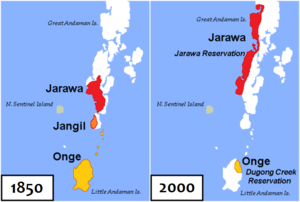Ongan languages
| Ongan | |
|---|---|
| South Andamanese | |
| Geographic distribution: |
Andaman Islands |
| Linguistic classification: | One of the world's primary language families; geographically among the Andamanese languages |
| Subdivisions: | |
| Glottolog: | jara1244 |

Distribution of the Ongan languages prior to 1850 (Fig. 1) and in 2005 (Fig. 2)
|
|
Ongan, also called South Andamanese or Jarawa–Onge, is a small family of two languages, Önge and Jarawa, spoken in the southern Andaman Islands:
The two extant languages are:
A third language, Jangil, extinct sometime between 1895 and 1920, is reported to have been unintelligible with but to have had noticeable connections with Jarawa.
The Andamanese languages fall into two clear families, Great Andamanese and Ongan, plus one presumed but unattested language, Sentinelese. The similarities between Great Andamanese and Ongan are mainly of a typological and morphological nature, with little demonstrated common vocabulary. Linguists, including long-range researchers such as Joseph Greenberg, have expressed doubts as to the validity of Andamanese as a family. It has since been proposed that Ongan (but not Great Andamanese) is distantly related to Austronesian in a family called Austronesian–Ongan, but the proposal has not been well received.
The two attested Ongan languages are relatively close, and the historical sound reconstruction mostly straightforward:
*ə appears to be allophonic for *e before a nasal coda.
The Ongan languages are agglutinative, with an extensive prefix and suffix system. They have a noun class system based largely on body parts, in which every noun and adjective may take a prefix according to which body part it is associated with (on the basis of shape, or functional association). Another peculiarity of terms for body parts is that they are inalienably possessed, requiring a possessive adjective prefix to complete them, so one cannot say "head" alone, but only "my, or his, or your, etc. head".
...
Wikipedia
